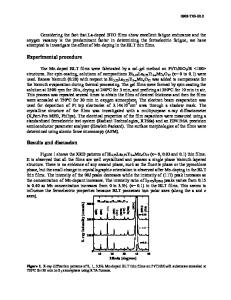Growth, characterization, and electrical properties of PbZr 0.52 Ti 0.48 O 3 thin films on buffered silicon substrates u
- PDF / 179,853 Bytes
- 4 Pages / 612 x 792 pts (letter) Page_size
- 66 Downloads / 458 Views
Alex Kvit and A.K. Sharma North Carolina State University, Materials Science Department, Raleigh, North Carolina 27695-7916
C.B. Lee and Ward J. Collis Department of Electrical Engineering, North Carolina Agricultural and Technical State University, 551 McNair Hall, Greensboro, North Carolina 27411
J. Sankar NSF Center for Advanced Materials and Smart Structures, North Carolina Agricultural and Technical State University, Greensboro, North Carolina 27411
J. Narayan North Carolina State University, Materials Science Department, Raleigh, North Carolina 27695-7916 (Received 20 June 2002; accepted 14 October 2002)
Epitaxial thin films of PbZr0.52Ti0.48O3 (PZT) were synthesized successfully on SrRuO3/SrTiO3/MgO/TiN/Si heterostructures by pulsed laser deposition. The films were single phase and had (001) orientation. The deposition parameters were varied to obtain the best epitaxial layer for each of the compounds. Transmission electron microscopy indicated good epitaxy for the entire heterostructure and sharp interfaces between the epilayers. Dielectric and P–E hysteresis loop measurements were carried out with evaporated Ag electrodes. The dielectric constant for the films was found to be between 400–450. The value of saturation polarization Ps was between 55–60 C/cm2, and the coercive field Ec varied from 60–70 kV/cm. Integration of PZT films with silicon will be useful for future memory and micromechanical devices. I. INTRODUCTION
Recently, there has been extensive research on oxidebased ferroelectric materials because their ferroelectric and dielectric properties have potential applications in microelectronic circuitry, which includes nonvolatile memory elements, microsensors, capacitors for dynamic random access memories, surface acoustic wave (SAW) devices, and optical waveguides. PbZr0.52Ti0.48O3 (PZT) is a perovskite-type ferroelectric material with excellent piezoelectric, dielectric, and ferroelectric properties. The synthesis, processing, and electrical properties of PZT thin films have been studied intensively since it can be used for SAW delay lines, ferroelectric field effect transducers, pyroelectric sensors, radiation-hard nonvolatile random access memories, and dynamic random access memories.1,2 Potential applications of nonvolatile ferroelectric random access memories include smart cards, high-speed telecommunications, radio frequency tags, etc.3 There have been ongoing efforts to integrate ferroelectric thin films with existing silicon technology to fabricate reliable nonvolatile memories. Conventionally, polycrystalline ferroelectric thin films such as PZT are J. Mater. Res., Vol. 18, No. 1, Jan 2003
http://journals.cambridge.org
Downloaded: 15 Mar 2015
grown on silicon substrates with Pt as the bottom electrode: Pt/Ti/SiO2/Si has been used very commonly.4,5 Pt has been used because of its good metallic properties and its high oxidation resistance. However, PZT capacitors with Pt top and bottom electrodes tend to show a strong loss of switchable polarization. Conducting oxide electrodes have
Data Loading...











